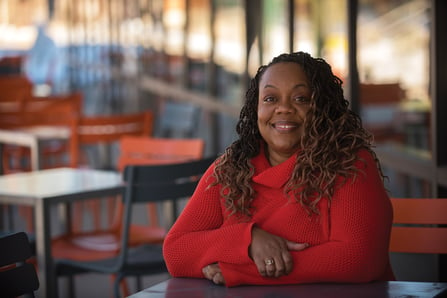
The outdoor industry at large recognizes its substantial challenges in the areas of diversity, equity, and inclusion (DEI). Unfortunately, many organizations — and especially small businesses — don’t know where to begin when attempting to make change.
This case study examines the motivations, goals, and outcomes of one outdoor business dedicated to advancing DEI within their company, offering strategies for other small businesses in the outdoor industry to consider.
Cairn was founded by Rob Little and Jared Peterson, friends from graduate school who left their corporate jobs to follow their entrepreneurial dreams in the outdoor industry.
Cairn offers monthly subscriptions to new outdoor products with the opportunity to gear up and give feedback. That feedback is provided back to the outdoor brands and development teams that fill Cairn boxes and is used to introduce new or redesigned products to the market.
Based in Bend, Oregon, Cairn has nine employees, and with the recent acquisition by Outside, Inc., the company is quickly expanding its services, team, and physical footprint.
.jpg)
Cairn co-founders, Jared Peterson (left) and Rob Little

Erika McCalpine, Founding Director of the DEI Lab
Launched in 2020, the DEI Lab’s mission is to advance social equity and inclusion in Central Oregon, a region where an estimated 12% of the population is made up of people of color. The Lab provides intensive diversity and inclusivity training for businesses and organizations in all industries, advising employers on hiring practices, unconscious bias, and other DEI-related needs.
Erika McCalpine — Executive Director of Strategic Diversity Initiatives, and a recognized advocate for advancing social equity and inclusion — leads the Lab.
Cairn's mission and values are centered around belonging and community, and the events of 2020 strongly affected the team and forced them to pause, reflect, and examine their intentions. Cairn strives to create a diverse and inclusive environment for their customers and their employees, but the company’s leadership team realized it takes more than good intentions to make real change.
It started with a public commitment. Cairn signed the Outdoor Industry CEO Diversity Pledge and committed to advancing diversity and inclusion as part of their brand’s ethic and ethos, both in their internal behaviors, practices, and policies, and in their external connections with customers and the outdoors.
The Cairn team started to meet monthly to talk about their new commitment to advancing DEI internally as a company and externally with their customers and brand partners. They read books, listened to podcasts, shared articles, and talked about how recent events were impacting them personally and professionally. Within a few short months, Cairn committed to several goals and objectives to turn their commitment to action in advancing DEI within the company.
Cairn began tracking the following metrics:
As a small business, Cairn was realistic about its resources knowing that an informal structure, busy project schedules, limited financial resources, and a lack of understanding and awareness required the team to be honest with one another. Team members recognized that they were people with similar identities, upbringings, and experiences. Trying to do DEI work on their own felt disingenuous, and without a formal human resources department to guide them, the team collectively decided that external support would be necessary to uncover ways the company could create a more diverse and inclusive work environment.
After setting aside $10,000 for organizational and professional development trainings for the year, the Cairn team members reached out to their networks for recommendations. However, they quickly realized this type of consultation was hard to find and costly.
In their search for a consultant, Rob and Jared learned about the launch of the DEI Lab at Oregon State University-Cascades, just a few short miles from Cairn headquarters. After an introductory meeting with the Lab’s founding director, Erika McCalpine, Cairn engaged with the DEI Lab to conduct an organizational assessment and to provide a series of training sessions in 2021.
"We felt so lucky to have met Erika and that she was here in Bend. She understands the needs of our business and our industry, all in the context of Central Oregon. - Jared Peterson, Cairn

Drawing on a foundation of deeply researched best practices, the DEI Lab comprehensively supports organizations in their progress toward significant diversity, equity, and inclusion goals. The DEI Lab developed an approach with Cairn that met the needs and realities of the company.
Starting with an organizational assessment, the DEI Lab developed an engagement and progress plan for the company. The organizational assessment for Cairn included:
In Erika's words: "The organizational assessment is a critical first step. It’s important to meet people where they are and to understand that there is no one-size-fits-all approach to this work."
Based on findings from the organizational assessment, the DEI Lab tailored a series of training sessions for Cairn:
In Erika's words: “I went over some common terms and definitions that the employees probably have heard. They referenced the social justice movement that happened last summer (in 2020) as their motivation for wanting to dive deeper into this work. So I made sure to cover terms that they probably heard in the media or read during that time, and I provided academic definitions for them. And then we went on to discuss where our biases come from, and the fact that everybody has biases, how we learn from them, and then how we change them.”
At the end of the engagement, the DEI Lab provided recommendations to refine or implement human resources and marketing practices that can foster a more diverse, equitable, and inclusive workplace.
Erika’s recommendations to Cairn included:

While this work is never done, the co-founders offered a few key takeaways from their experience. They invite their peers, colleagues, customers, and employees to step into the work, and to keep at it.
Diversity, equity, and inclusion are inherently interrelated, but they are also distinct concepts that require different commitments. DEI is not a program, department, or marketing campaign, but rather a cultural shift in viewing and valuing the differences of DEI.
This shift starts with testing organizational assumptions—from how we define leadership, develop career paths, and even how we do our jobs. Dominant cultural norms are prevalent within most organizations, and it’s important to ask whether those are the best ways to attract, retain, develop, and promote talent.
Tokenism, discrimination, blanket policies, missed opportunities for business growth, and a lack of psychological safety for employees are all very real risks for organizations that may strive for diversity and overlook inclusion and equity.
DEI is a continuous effort that requires intentionality, continued learning, expertise, and investment.
Companies need to assess the organizational environment and address racism, discrimination, and bias among its workforce. Addressing unconscious bias and the effects of microaggressions — subtle slights, insults, or indignities — is critical for organizations to ensure a safe working environment where employees feel valued, respected, accepted, and encouraged to fully participate.
Without inclusion, the connections that attract diverse talent, encourage their participation, foster innovation, and lead to business growth just won’t happen. These issues are not limited to the company's internal environment and workplace. The community matters, too.
Demonstrating a commitment to DEI requires transparency and accountability. It is important for leadership to communicate their DEI aspirations while also addressing areas of focus and opportunities to improve.
Employees at Cairn were invited into the process, which created a foundation of trust and safety. By collectively establishing goals, employees can hold leadership and each other accountable.
This accountability can and should extend beyond the organization — reaching out to industry peers, professional networks, along with HR, talent, and DEI experts who can provide a different perspective.
Industry commitments like the CEO Pledge are tangible, public ways for companies to engage, connect, and commit to new ways of working.
While off-the-shelf, low-cost DEI trainings are effective in increasing knowledge and improving awareness, they typically fall short when it comes to changing long-term behaviors.
The most productive kind of training is facilitated by a trained professional encouraging empathy and interaction as a group over a period of time. Experienced consultants can tailor trainings to meet the needs of individuals and support goal-setting that can measure personal and organizational change.
Unconscious or implicit biases are formed over one’s lifetime, and it takes time, space, and support for change to happen.
In 2021, Cairn was acquired by a larger company, Outside, Inc. Cairn now finds itself in a unique position to have expanded positive impact on the company's DEI practices. The company can apply learnings from its DEI engagement to its immediate team while also exploring opportunities to elevate DEI considerations and actionable improvements to the larger Outside organization (500+ employees).
Important questions to consider as Cairn looks forward:

“The work Cairn did with Erika and the DEI Lab has been the first step in a long journey. It’s given us the vulnerability and confidence we need to continue on the road ahead.”
- Rob Little, Cairn
“Rob and Jared expressed their commitment to this work. They put their money where their mouth was. They weren't just saying things for the moment. They really did something tangible in trying to move the organization forward with diversity, equity, and inclusion. Because it's such a small company, they were able to influence outcomes more quickly. I think the employees saw that. And I do believe that Cairn has created a culture where people feel very comfortable using their voices to talk about these issues and their experiences.”
- Erika McCalpine, DEI Lab


The Center for the Outdoor Recreation Economy is dedicated to advancing research and curriculum development, technical skills training and leadership programming for the U.S. outdoor industry.
We'd love to hear from you. Contact us at outdooreconomy@oregonstate.edu.